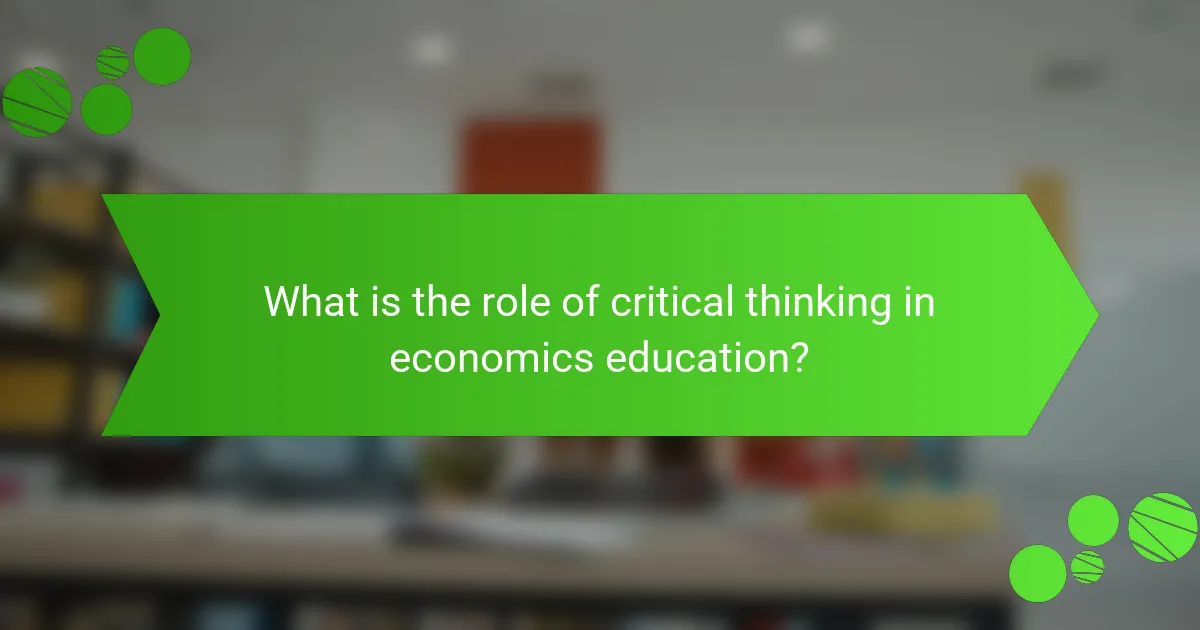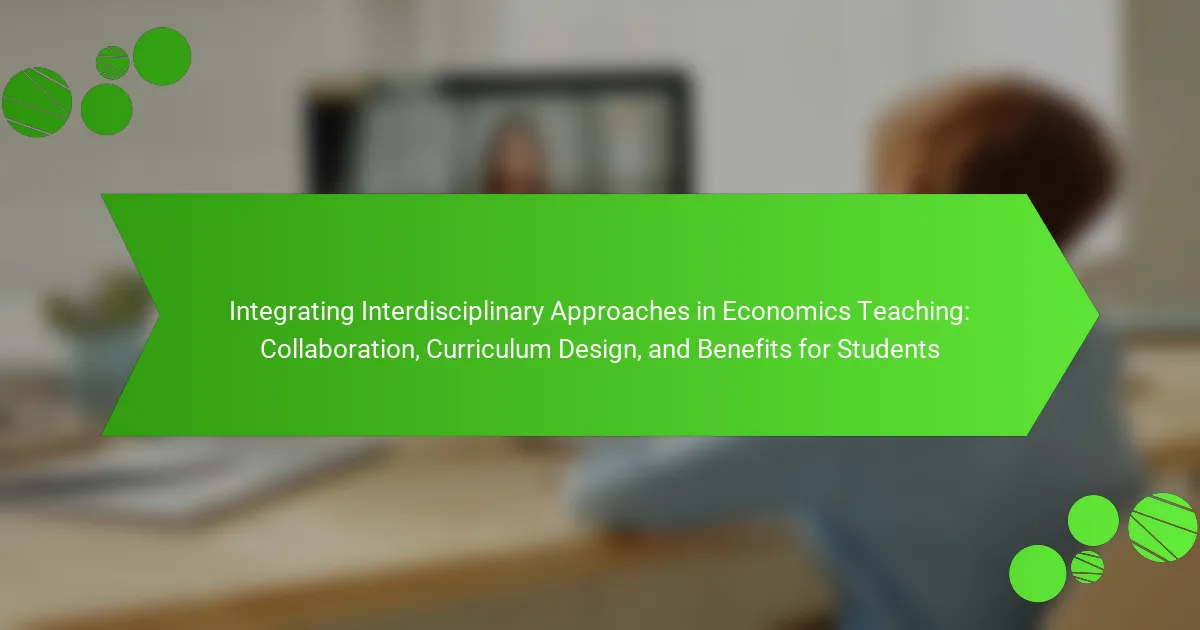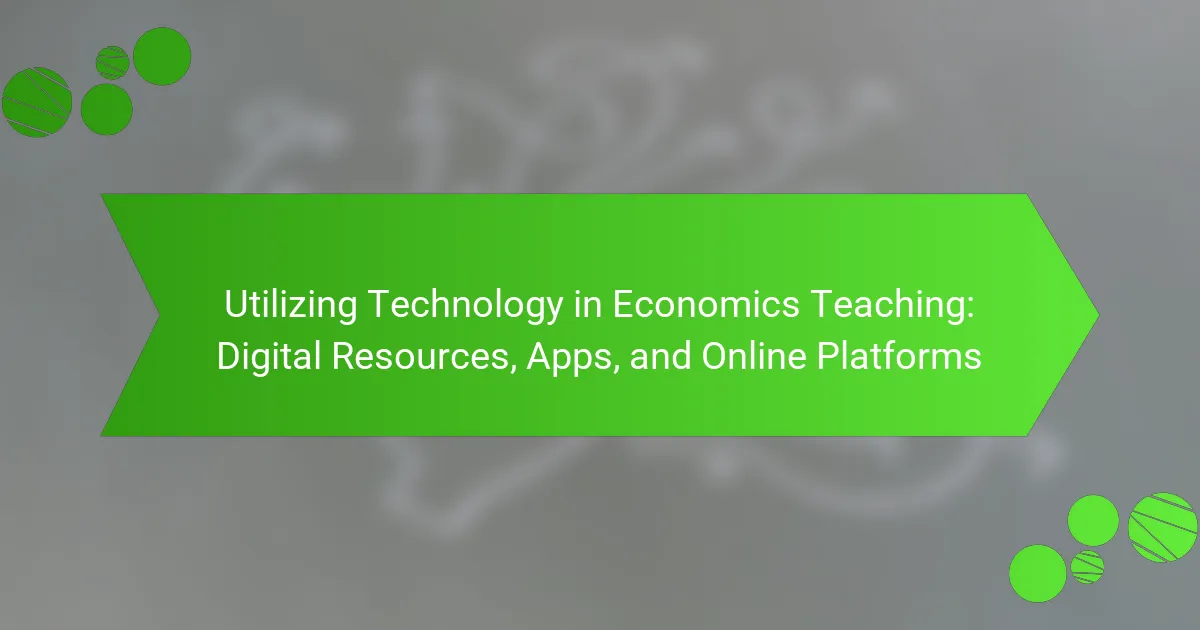Critical thinking is essential in economics education, allowing students to analyze complex concepts and evaluate arguments effectively. This article explores various techniques, activities, and assessment methods for integrating critical thinking into economics curricula. It highlights the positive impact of critical thinking on students’ understanding of economic theories and their overall decision-making and problem-solving skills. Research, including findings from the National Council for Excellence in Critical Thinking, underscores the necessity of these skills in preparing students for real-world economic challenges. The discussion will provide educators with practical strategies to enhance critical thinking in their teaching practices.

What is the role of critical thinking in economics education?
Critical thinking plays a crucial role in economics education. It enables students to analyze complex economic concepts and evaluate various arguments. This skill fosters informed decision-making and enhances problem-solving abilities. Critical thinking encourages students to question assumptions and assess evidence critically. Research shows that students who engage in critical thinking perform better in understanding economic theories. A study by the National Council for Excellence in Critical Thinking highlights the importance of these skills in developing analytical capabilities. Consequently, integrating critical thinking into economics education prepares students for real-world challenges.
How can critical thinking enhance economic understanding?
Critical thinking enhances economic understanding by fostering analytical skills and promoting informed decision-making. It allows individuals to evaluate economic models critically and assess their real-world applicability. By questioning assumptions, critical thinkers can identify biases in economic theories. This leads to a more nuanced understanding of market dynamics and consumer behavior. Moreover, critical thinking encourages the exploration of alternative economic solutions. Research shows that students who engage in critical thinking exercises perform better in economics courses. This correlation highlights the importance of integrating critical thinking into economics education. Ultimately, it equips learners with the tools to navigate complex economic landscapes effectively.
What are the key attributes of critical thinking in economics?
The key attributes of critical thinking in economics include analysis, evaluation, and synthesis. Analysis involves breaking down complex economic problems into manageable parts. It allows individuals to understand the underlying components of economic theories and models. Evaluation requires assessing the credibility and relevance of economic data and arguments. This ensures informed decision-making based on sound evidence. Synthesis involves integrating various economic perspectives and information to form coherent conclusions. These attributes enable individuals to approach economic issues logically and systematically. They foster a deeper understanding of economic principles and enhance problem-solving skills.
Why is critical thinking essential for economic decision-making?
Critical thinking is essential for economic decision-making because it enables individuals to analyze complex information effectively. This skill helps in evaluating various economic scenarios and understanding their implications. Critical thinking allows decision-makers to identify biases and assumptions in data. It also facilitates the comparison of different economic models and strategies. Furthermore, it aids in predicting outcomes based on available evidence. For instance, a study by the National Council for Excellence in Critical Thinking highlights that critical thinking improves problem-solving abilities. This ultimately leads to more informed and rational economic choices.
What techniques can be used to incorporate critical thinking in economics education?
Techniques to incorporate critical thinking in economics education include case studies, problem-based learning, and debates. Case studies allow students to analyze real-world economic scenarios. This method encourages them to evaluate different perspectives and outcomes. Problem-based learning presents students with complex economic problems to solve collaboratively. It promotes analytical skills and fosters teamwork. Debates encourage students to articulate and defend their viewpoints on economic issues. This technique enhances their ability to think critically and engage with opposing arguments. Additionally, using simulations can immerse students in economic decision-making processes. This hands-on approach allows them to apply theoretical knowledge in practical contexts. Overall, these techniques effectively develop critical thinking skills in economics education.
How do problem-based learning strategies foster critical thinking?
Problem-based learning strategies foster critical thinking by engaging students in real-world problems. These strategies require learners to analyze situations, identify issues, and develop solutions. Students must evaluate information critically and consider multiple perspectives. This approach enhances their ability to reason and make informed decisions. Research shows that students in problem-based learning environments demonstrate improved critical thinking skills. A study by Hmelo-Silver (2004) indicates that such strategies promote deeper understanding and application of knowledge. This evidence supports the effectiveness of problem-based learning in developing critical thinking abilities.
What role does Socratic questioning play in economics classrooms?
Socratic questioning enhances critical thinking in economics classrooms. It encourages students to engage deeply with economic concepts. This method fosters a dialogue that challenges assumptions and promotes analytical skills. By asking open-ended questions, teachers guide students to explore the implications of economic theories. Research shows that this approach improves students’ ability to reason and articulate their thoughts. For instance, a study by Paul and Elder highlights that Socratic questioning leads to higher-order thinking. In this way, it cultivates a learning environment that values inquiry and discussion in economics education.
What activities promote critical thinking in economics education?
Activities that promote critical thinking in economics education include debates, case studies, and simulations. Debates encourage students to articulate and defend their viewpoints on economic issues. Case studies allow students to analyze real-world economic scenarios and develop solutions. Simulations provide experiential learning opportunities where students can apply economic principles in a controlled environment. Research indicates that these activities enhance analytical skills and foster deeper understanding. For example, a study by the National Council on Economic Education found that students engaged in active learning activities performed better in understanding economic concepts. These methods create an interactive learning environment that stimulates critical thinking.
Which interactive activities engage students in critical economic analysis?
Interactive activities that engage students in critical economic analysis include role-playing simulations, case studies, and debates. Role-playing simulations allow students to assume different economic roles, enhancing their understanding of market dynamics. Case studies provide real-world scenarios for analysis, encouraging students to apply theoretical concepts. Debates foster critical thinking by requiring students to defend positions on economic issues. Research shows that these activities improve engagement and analytical skills in economics education. For example, a study by Becker and Watts (2001) found that active learning techniques significantly enhance student performance in economics courses.
How can case studies be utilized to develop critical thinking skills?
Case studies can be utilized to develop critical thinking skills by providing real-world scenarios for analysis. They encourage students to evaluate complex situations, identify key issues, and consider multiple perspectives. This method promotes active engagement and deeper understanding of the subject matter. Students must synthesize information and draw conclusions based on evidence presented in the case. Research shows that students who engage with case studies demonstrate improved problem-solving abilities. A study by Herreid and Schiller found that case-based learning enhances critical thinking skills significantly in higher education settings.
How can assessment methods evaluate critical thinking in economics?
Assessment methods can evaluate critical thinking in economics through various techniques. These methods include case studies, problem-solving tasks, and reflective essays. Case studies require students to analyze real-world economic scenarios. This analysis fosters deeper understanding and application of economic concepts. Problem-solving tasks challenge students to apply theoretical knowledge to practical situations. These tasks assess students’ ability to think critically and make informed decisions. Reflective essays encourage students to articulate their thought processes and reasoning. This articulation reveals their critical thinking skills and understanding of economic principles. Effective assessment methods align with learning objectives and provide measurable outcomes. Research shows that diverse assessment strategies enhance critical thinking development in economics education.
What types of assessments effectively measure critical thinking skills?
Performance assessments effectively measure critical thinking skills. These assessments require students to apply their knowledge in real-world scenarios. They often involve problem-solving tasks or projects. Rubrics can be used to evaluate students’ reasoning and decision-making processes. Another effective method is the use of case studies. Case studies present complex situations requiring analysis and synthesis of information. Additionally, reflective journals encourage students to articulate their thought processes. Research supports that these methods enhance critical thinking abilities. A study by Facione (2011) emphasizes the importance of performance tasks in assessing critical thinking.
How can rubrics be designed to assess critical thinking in economics assignments?
Rubrics can be designed to assess critical thinking in economics assignments by including specific criteria that reflect critical thinking skills. These criteria may include analysis, evaluation, synthesis, and application of economic concepts. Each criterion should have clear descriptors that define performance levels, such as exemplary, proficient, and needs improvement. For example, analysis can be assessed by evaluating how well a student identifies and explains economic theories. Evaluation can focus on the student’s ability to assess the validity of different economic arguments. Synthesis can involve the integration of various economic data to form coherent conclusions. Application can be measured by how effectively students apply economic concepts to real-world situations. Research supports that well-defined rubrics enhance objectivity in grading and provide students with clear expectations.
What challenges might educators face in incorporating critical thinking?
Educators face several challenges in incorporating critical thinking into their teaching. One major challenge is a lack of training in critical thinking pedagogy. Many educators have not received formal education on how to teach these skills effectively. Another challenge is time constraints within the curriculum. Educators often feel pressured to cover specific content, leaving little room for in-depth critical thinking activities.
Additionally, there may be resistance from students who are accustomed to traditional rote learning. Some students may struggle to engage with more analytical and evaluative tasks. Assessment methods can also pose challenges; standardized tests often do not measure critical thinking skills effectively.
Finally, limited resources and support can hinder educators’ ability to implement innovative teaching strategies. Research indicates that educators who lack institutional support may find it difficult to prioritize critical thinking in their classrooms.
How can resistance to critical thinking be addressed in the classroom?
Resistance to critical thinking can be addressed in the classroom through various strategies. One effective method is fostering a supportive environment that encourages open dialogue. Teachers should model critical thinking by demonstrating thought processes and reasoning. Providing real-world examples relevant to economics can engage students and illustrate the importance of critical thinking. Additionally, incorporating collaborative activities allows students to share perspectives and challenge each other’s ideas. Regular feedback helps students understand their thought processes and improve. Training teachers in critical thinking pedagogy is also essential for creating effective learning experiences. Research shows that classrooms promoting critical thinking lead to enhanced student engagement and understanding.
What strategies can help overcome common obstacles in teaching economics?
Utilizing active learning strategies can help overcome common obstacles in teaching economics. Engaging students through discussions, group projects, and simulations enhances understanding. Incorporating real-world examples makes abstract concepts relatable. Using technology, such as online simulations and data analysis tools, fosters interactive learning. Providing clear, structured frameworks for analysis aids comprehension. Regular formative assessments offer feedback and guide instruction. Encouraging collaborative learning promotes peer-to-peer teaching. These strategies have been shown to improve student engagement and retention in economics courses.
What are best practices for fostering critical thinking in economics education?
Best practices for fostering critical thinking in economics education include encouraging active learning and promoting inquiry-based approaches. Active learning engages students in discussions, debates, and problem-solving activities. Inquiry-based learning allows students to explore economic concepts through questions and research.
Utilizing real-world case studies enhances critical thinking by applying theoretical knowledge to practical situations. Incorporating simulations and role-playing exercises helps students understand complex economic interactions.
Facilitating peer discussions encourages diverse perspectives and collaborative learning. Providing timely feedback on assignments enhances students’ analytical skills.
Integrating technology, such as online discussion forums, fosters continuous engagement and exploration of economic topics. These strategies collectively support the development of critical thinking skills in economics education.
How can educators create a supportive environment for critical thinking?
Educators can create a supportive environment for critical thinking by fostering open dialogue and encouraging questioning. This involves promoting a culture where students feel safe to express their ideas. Providing diverse perspectives enhances critical analysis. Incorporating real-world problems allows students to apply their thinking skills. Collaborative group work encourages peer feedback and discussion. Utilizing formative assessments helps educators gauge student understanding. Research indicates that classrooms emphasizing critical thinking improve student engagement and outcomes. For example, a study by Facione (2011) found that critical thinking skills significantly enhance academic performance.
What resources are available for teachers to enhance critical thinking in economics?
Teachers can access various resources to enhance critical thinking in economics. Online platforms like the Council for Economic Education offer lesson plans and teaching materials. The National Council for the Social Studies provides resources that integrate economics with critical thinking exercises. Additionally, the Economic Education Journal publishes research and articles focused on effective teaching strategies. Websites like Edutopia feature articles and videos on fostering critical thinking in economics. Books such as “Teaching Economics: More Alternatives to Chalk and Talk” provide practical approaches for educators. These resources collectively support teachers in developing students’ analytical and evaluative skills in economics.
The primary entity of this article is the integration of critical thinking in economics education. The article outlines the significance of critical thinking in enhancing students’ analytical skills, informed decision-making, and problem-solving abilities within the context of economics. It discusses various techniques such as case studies, problem-based learning, and Socratic questioning, while also highlighting the role of interactive activities and effective assessment methods in fostering critical thinking. Additionally, it addresses challenges educators may face and offers best practices and resources to support the development of critical thinking skills in economics classrooms.



